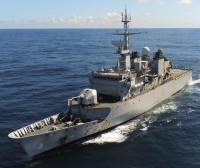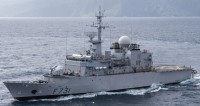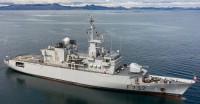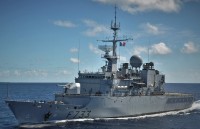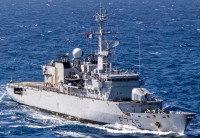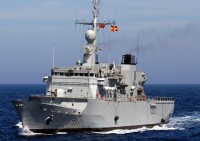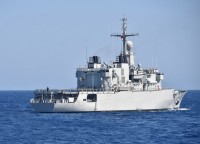Floreal-class frigate
Basic information
Ship measurements
Machine
- 4 * SEMT Pielstick 6 PA6 L280 BPC diesel engines
- 6,580 kW (8,820 hp)
- 2 * shafts, 1 * 203 kW (272 hp) bow thruster
Personnel
Combat assets
- DRBV-21C (Mars) air sentry radar
- Racal Decca RM1290 navigation radar
- Racal Decca RM1290 landing radar
- ARBG-1A Saïgon
- 2 * Dagaie decoy systems
- 2 * Exocet MM38 missiles (originally fitted; now removed)
- 1 * 100 mm CADAM turret with Najir fire control system
- 2 * 20 mm modèle F2 guns
- 1 * Panther helicopter or Dauphin N3 (the latter replaced former Aérospatiale Alouette III on some ships in 2022)
The Floréal class is a type of light «surveillance frigates» designed for the needs of the French Navy in low-threat environments ordered in 1989. The ships are named after months of the Republican Calendar. They use construction standards of commercial ships. The frigates were built between 1990 and 1993 by the Chantiers de l'Atlantique at Saint-Nazaire, France. The six French ships of the class, Floréal, Prairial, Nivôse, Ventôse, Vendémiaire and Germinal, remain in active service.
The ships' main armament was two Exocet MM38 surface-to-surface missiles and a 100 mm (4 in) CADAM turret, but in 2014, the Exocets were removed at the end of their life cycle. The vessels have a maximum speed of 20 knots (37 km/h; 23 mph) and can carry 24 marines. The vessels are used mainly to patrol the French overseas departments and regions in the Pacific, Indian Ocean and Caribbean regions, but have served in both military and humanitarian operations in the Persian Gulf and the Gulf of Guinea.
Two more ships were ordered by the Royal Moroccan Navy in July 1999. Constructed by Chantiers de l'Atlantique in 2001–2002, they resemble the French vessels with minor changes. Their main armament are the two Exocet missiles and a Otobreda 76 mm gun. The two frigates, Mohammed V and Hassan II, entered service in 2002–2003 and are used primarily for training and patrol.
The Floréal class evolved out of a need to produce a cheaper frigate for patrol in the low-threat environments of France's territorial waters and exclusive economic zone. The hull and superstructure are made of welded steel with transverse bulkheads. Frigates of the Floréal class have a standard displacement of 2,642 tonnes and 3,000 tonnes at full load. The frigates measure 85.2 metres long between perpendiculars and 93.5 metres overall with a beam of 14 metres and a draught of 4.3 m. Due to the frigates' broad beams, they are equipped with fin stabilisers.
The frigates are powered by a combined diesel and diesel (CODAD) system comprising four SEMT Pielstick 6 PA6 L280 BPC diesel engines driving two shafts each turning a LIPS controllable pitch propeller. The CODAD system is rated at 6,580 kilowatts (8,820 hp) The vessels are also equipped with one 203-kilowatt (272 hp) bow thruster. They also have twin rudders. Due to the mercantile construction design, the four diesels are all located within one machinery room for ease of maintenance. Both diesel fuel and TR5 aviation fuel is brought aboard at a single location at the stern compared to naval-constructed vessels which sport two. The ships also have three 750 kW (1,010 hp) diesel-electric generators located just fore and aft of the machinery room. The Floréal-class frigates have a maximum speed of 20 knots (37 km/h; 23 mph) and a range of 9,000 nautical miles (17,000 km; 10,000 mi) at 15 knots (28 km/h; 17 mph).
The class was initially only to be armed with the weaponry that would be required for the patrol mission, but this was later increased. The frigates were armed with two Exocet MM38 surface-to-surface missiles in launchers situated centrally atop the midships superstructure. Each missile had a range of 42 kilometres, carried a 165 kg warhead and could reach speeds up to Mach 0.9. However, at the end of the missile's life cycle in 2014, the launchers were removed as the French Navy did not intend to replace the capability aboard the ships. The ships mount one 100 mm CADAM turret with the Najir fire control system located forwards. The 100 mm (4 in) gun can fire 78 rounds per minute, each round weighing 13.5 kg (30 lb) up to a range of 17 kilometres. The frigates are also equipped with two 20 mm modele F2 guns situated in atop the aft superstructure which can fire 720 rounds per minute up to 10 kilometres. The frigates are equipped with DRBV-21C (Mars) air sentry, Racal Decca RM1290 navigation and Racal Decca RM1290 landing radars along with ARBG-1A Saïgon communications intercept, CSF ARBR 16A radar intercept electronic surveillance systems and two Dagaie decoy systems.
Ships of the Floréal class mount a 30-by-15-m helicopter landing pad located on the stern and a 10-by-15-m hangar. The frigates are capable of operating the embarked Eurocopter AS565 Panther up to sea state 5, and are capable of operating helicopters up to the size of the Eurocopter AS332 Super Puma. However, as late as 2021, Aérospatiale Alouette III helicopters were also being embarked, notably in the Pacific region. In 2022, the Eurocopter Dauphin N3 was earmarked to replace the Aérospatiale Alouette III aboard some ships when the Alouette IIIs were withdrawn from service. The vessels have a complement of 90 including the aircrew and officers and 24 marines with capacity for a further 13 personnel. The ships are equipped with improved medical facilities including a consultation room and hospital beds for use during humanitarian missions.
The first two ships were ordered on 20 January 1989, the second pair on 9 January 1990 and the final two in January 1991. The ships are named after months of the Republican Calendar. The ships were built by Chantiers de l'Atlantique at Saint-Nazaire, France. They were built using civilian construction methods as a cost saving measure. The reduction in cost allowed the French Navy to build three for the price of one La Fayette-class frigate. This method was also used for the later La Fayette class. Following sea trials, the vessels were sent to Arsenal de Lorient at Lorient to have their weapons installed.
The Floréal-class frigates main purpose for the French Navy is to patrol and support French forces in the French overseas departments and regions. The vessels can also be used for humanitarian missions, ship escort and special missions. Floréal and Nivôse are based at Réunion, Vendémiaire at Nouméa, Prairial at Tahiti and Ventôse and Germinal at Martinique. The frigates have served in military operations as part of the Australian-led INTERFET, in Operation Enduring Freedom in the Persian Gulf and in Operation Atalanta off the coast of Somalia. They have served in hurricane relief forces, and recovery operations for crashed aircraft.
It is anticipated that the class will be replaced in French service in the 2030s with the planned European Patrol Corvette.
Royal Moroccan Navy
The Royal Moroccan Navy operates two Floréal-class frigates, Mohammed V and Hassan II. The two frigates are named after the late Kings Mohammed V and Hassan II. They were acquired with three Panther helicopters in July 1999. The Moroccan frigates of the class are similar to those in French service with a few changes. The frigates are powered by a CODAD system comprising the same four SEMT Pielstick 6 PA6 L280 BPC diesel engines driving two shafts each turning a LIPS controllable pitch propeller. The CODAD system is rated at 7,200 kilowatts (9,600 hp) The vessels are also equipped with one 250-kilowatt (340 hp) bow thruster. Other differences include one Otobreda 76 mm (3 in) gun turret with Najir fire control system located forwards instead of the French 100 mm gun. The frigates are capable of being armed with two 20 mm modèle F2 guns situated in atop the aft superstructure, but did not come with the weapons installed. In place of the 20 mm (0.8 in) guns, the Moroccan Floréal-class frigates can be fitted with twin launchers for Simbad surface-to-air missiles. The Moroccan frigates are equipped with two Decca Bridgemaster radars, one for use as navigational radar, the other for helicopter control, and Thomsen-CSF ARBR 17 radar intercept electronic surveillance system.
Ships8
- Comments
 en
en ru
ru uk
uk
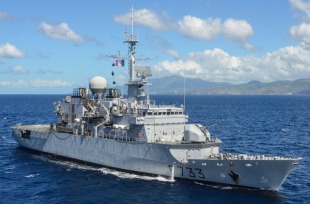





 Royal Moroccan Navy
Royal Moroccan Navy French Navy (Marine Nationale)
French Navy (Marine Nationale)